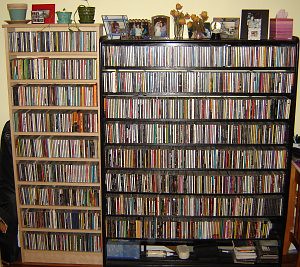Sound and the City
Albums: Feast of Wire (Calexico); Glum, Chore of Enchantment, Cover Magazine (GS); Hisser (HG)
Source: Bought used (all but Hisser, which was a promo)
It's strange to think that a place can have a sound. But Motown did its best to support the concept, creating a singular, recognizable sound that got matched up with the idea of "Detroit" (nevermind that the MC5, Stooges and even Ted Nugent could have an equal claim to the place). In the 80s there was an "Athens Sound" coming out of Georgia (which was mostly anyone who sounded kinda like R.E.M.), and lordy knows there was a "Seattle Sound" in the 90s.
But I think that those geographical sonics are often jointly temporal ones. Gamble & Huff nailed down a section of Philly in the 70s as much as Motown sounded like the Motor City the 60s and Sub Pop sounded like the Pacific Northwest circa 1992. Philadelphia doesn't sound like that in the late-oughts any more than Detroit or Seattle sound the same as they once did.
All of which makes Howe Gelb a bit of a curiosity. Starting in the mid-80s, Gelb has been making music that really sounds like the Arizona desert region he calls home. For the most part, Gelb records as the leader of Giant Sand (which for years featured the rhythm section of Joey Burns and John Convertino...who became the nucleus of Calexico), but regardless what moniker is on the cover, Gelb's music has this dusty, wide-open sound...one that's big enough that you can hear the coyotes and rattlers and tumbleweeds between the notes. Now, obviously this aural mood is mostly an exaggerated conception of how people think of America's Southwest - but even so,Gelb nails that conception and makes it real for the duration of each song.
I'm not 100% clear on how he does it, but there's obviously a science of sorts to it: Calexico, which is now a longstanding unit of its own, has the same sound-feeling in spades. Joey & John make their iteration a bit more cinematic and bring in more musical influences from around the world, but the desert dust still blows through the band's grooves. Gelb is unlikely to ever be celebrated as "The Berry Gordy of Arizona" or anything like that, but that may be largely because his sound-place isn't beholden to any particular era: Giant Sand, Calexico and Gelb's other stylistic progeny stand just far enough outside of a particular time to sound firmly planted in a specific place.
SISOSIG? While Gelb's sound is weirdly consistent across different band members, production styles and instrumentation, the quality of his releases is deeply erratic. Glum, which was part of his mid-90s grab at the Big Label Brass Ring, sounds a bit compromised and unfocused; Cover Magazine, which has a solid cover-song concept, is better but drags on a bit long without arriving at a solid reason for being. Both of these are pretty unnecessary, though I think only Glum deserves to be tossed (when Cover Mag grabs hold of a song by a like-minded spirit such as Neil Young, Nick Cave or Sonny Bono, it's often effective and affecting).
Chore of Enchantment and Feast of Wire, on the other hand, are career high points for Giant Sand and Calexico, respectively. Each is the sound of a band hitting every mark without looking down, and they both stand the test of as many spins as you'd care to to throw their way. I certainly like to play them loud & often.
Splitting the difference is Hisser. This odd little collection of half-formed Gelb solo recordings sounds like he just happened to hit play and record at the same time every now and then (which probably isn't too far from true). Some of these songs ended up in better, more fleshed-out version on subsequent Giant Sand discs, but most of these tunes and fragments are full of air, dust and flickering half-light. If all of these five discs sound just like the place they're from, Hisser is the one that ends up being the most succinct summation of the desert's natural music.
